Organizational Theory: Classical, Neo-Classical Approaches Analysis
VerifiedAdded on 2022/12/28
|9
|2586
|53
Report
AI Summary
This report delves into the realm of organizational theory, contrasting the classical and neo-classical approaches. It begins by outlining the classical approach, which emphasizes centralized leadership and profit maximization, often overlooking employee satisfaction and social needs. The report then explores the neo-classical perspective, portraying the company as a social system where human actions significantly impact performance, representing an evolution of the classical model. The main body of the report examines the key components of the classical approach, including scientific management, principles of organization, and bureaucratic approaches. It then discusses the neo-classical approach, highlighting human relations theory, motivation, leadership, and contingency theory. Furthermore, the report explores forces that shape organizations and their structure, such as contemporary marketing orientation, cultural excellence, Japanese approach, and organizational learning. The report concludes by summarizing the key differences between classical and neo-classical approaches, providing a comprehensive understanding of organizational theory.
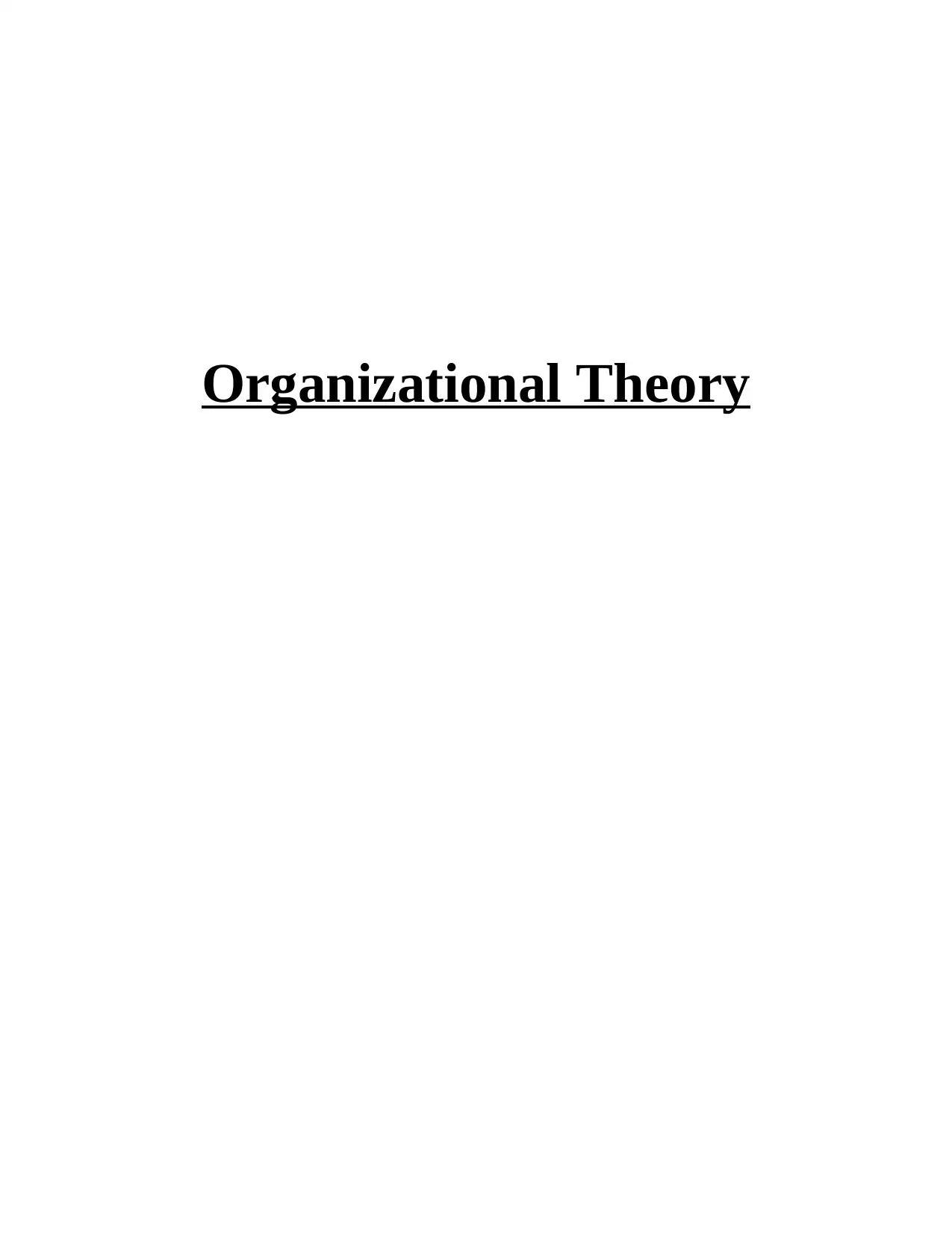
Organizational Theory
Paraphrase This Document
Need a fresh take? Get an instant paraphrase of this document with our AI Paraphraser
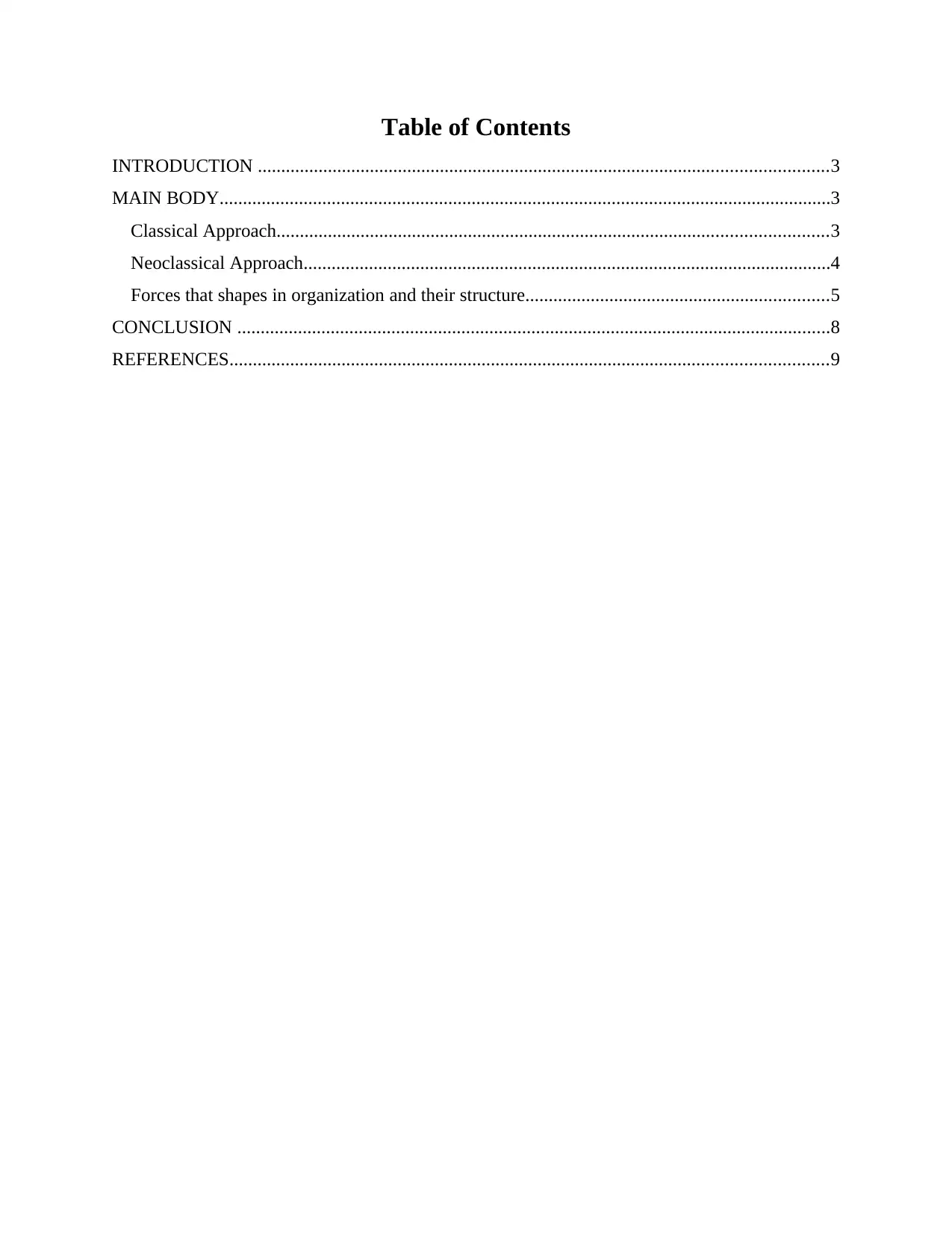
Table of Contents
INTRODUCTION ..........................................................................................................................3
MAIN BODY...................................................................................................................................3
Classical Approach......................................................................................................................3
Neoclassical Approach.................................................................................................................4
Forces that shapes in organization and their structure.................................................................5
CONCLUSION ...............................................................................................................................8
REFERENCES................................................................................................................................9
INTRODUCTION ..........................................................................................................................3
MAIN BODY...................................................................................................................................3
Classical Approach......................................................................................................................3
Neoclassical Approach.................................................................................................................4
Forces that shapes in organization and their structure.................................................................5
CONCLUSION ...............................................................................................................................8
REFERENCES................................................................................................................................9

INTRODUCTION
Classical theory belief that the employees have economic and physical needs only
completely ignoring the job satisfaction and social needs (Bharadwaj, 2017). It has centralized
leadership and focus on profits. Neo classical theory says that the company is the social system
and human actions affects the performance of the company, it is the advanced version of
classical theory. This study will discuss the contemporary marketing orientation, organizational
learning, cultural excellence and Japanese approach. Further it will discuss complete classical
and neo classical approach.
MAIN BODY
Classical Approach
Figure 1 Classical approach
Source: Classical approach to decision making., 2021
The classical approaches theory is one of the oldest theory which represent various
thoughts of organization. This theory also concentrate about structure in organization as well
their managements. The classical basically ignore human relations and do not determine the role
Classical theory belief that the employees have economic and physical needs only
completely ignoring the job satisfaction and social needs (Bharadwaj, 2017). It has centralized
leadership and focus on profits. Neo classical theory says that the company is the social system
and human actions affects the performance of the company, it is the advanced version of
classical theory. This study will discuss the contemporary marketing orientation, organizational
learning, cultural excellence and Japanese approach. Further it will discuss complete classical
and neo classical approach.
MAIN BODY
Classical Approach
Figure 1 Classical approach
Source: Classical approach to decision making., 2021
The classical approaches theory is one of the oldest theory which represent various
thoughts of organization. This theory also concentrate about structure in organization as well
their managements. The classical basically ignore human relations and do not determine the role
⊘ This is a preview!⊘
Do you want full access?
Subscribe today to unlock all pages.

Trusted by 1+ million students worldwide
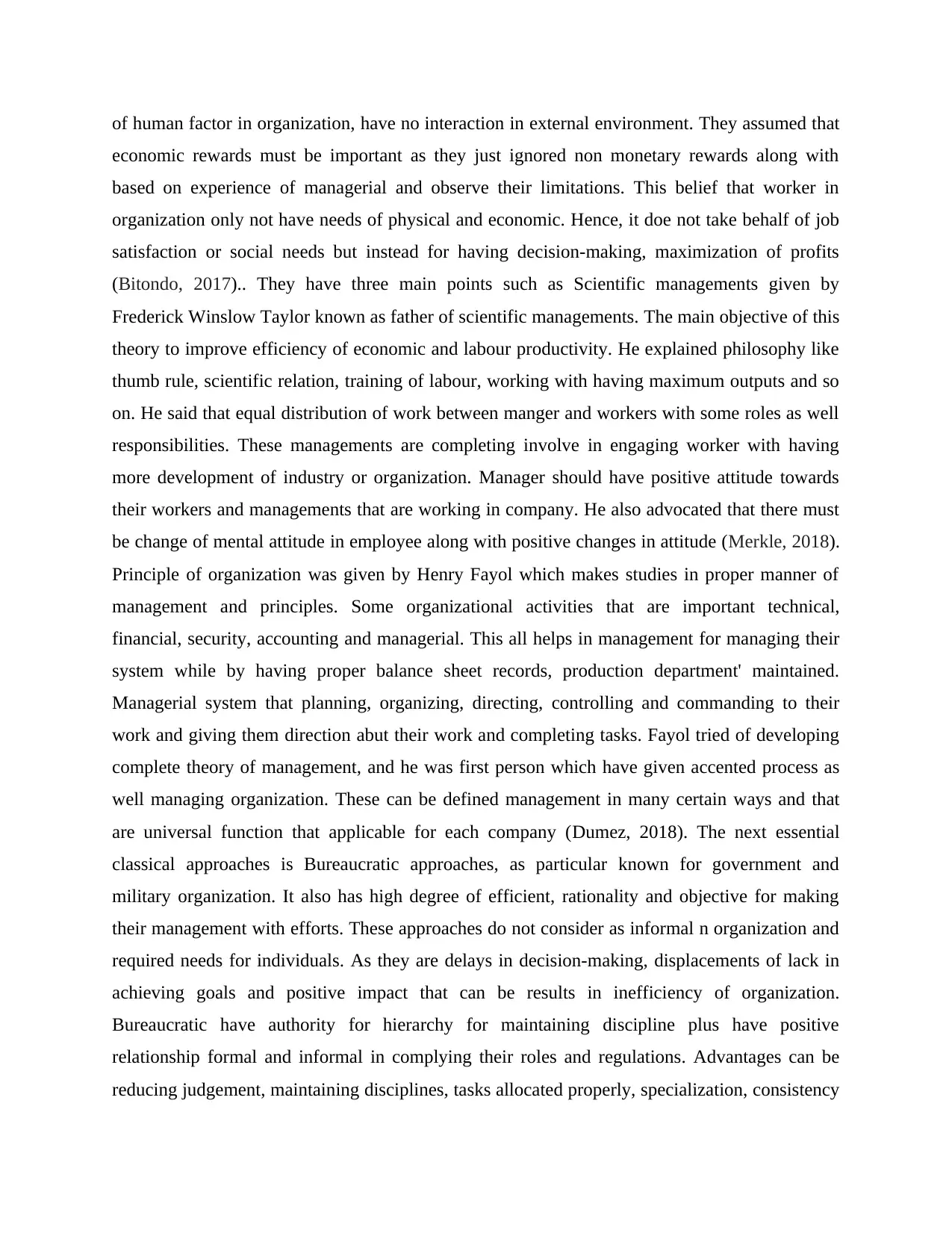
of human factor in organization, have no interaction in external environment. They assumed that
economic rewards must be important as they just ignored non monetary rewards along with
based on experience of managerial and observe their limitations. This belief that worker in
organization only not have needs of physical and economic. Hence, it doe not take behalf of job
satisfaction or social needs but instead for having decision-making, maximization of profits
(Bitondo, 2017).. They have three main points such as Scientific managements given by
Frederick Winslow Taylor known as father of scientific managements. The main objective of this
theory to improve efficiency of economic and labour productivity. He explained philosophy like
thumb rule, scientific relation, training of labour, working with having maximum outputs and so
on. He said that equal distribution of work between manger and workers with some roles as well
responsibilities. These managements are completing involve in engaging worker with having
more development of industry or organization. Manager should have positive attitude towards
their workers and managements that are working in company. He also advocated that there must
be change of mental attitude in employee along with positive changes in attitude (Merkle, 2018).
Principle of organization was given by Henry Fayol which makes studies in proper manner of
management and principles. Some organizational activities that are important technical,
financial, security, accounting and managerial. This all helps in management for managing their
system while by having proper balance sheet records, production department' maintained.
Managerial system that planning, organizing, directing, controlling and commanding to their
work and giving them direction abut their work and completing tasks. Fayol tried of developing
complete theory of management, and he was first person which have given accented process as
well managing organization. These can be defined management in many certain ways and that
are universal function that applicable for each company (Dumez, 2018). The next essential
classical approaches is Bureaucratic approaches, as particular known for government and
military organization. It also has high degree of efficient, rationality and objective for making
their management with efforts. These approaches do not consider as informal n organization and
required needs for individuals. As they are delays in decision-making, displacements of lack in
achieving goals and positive impact that can be results in inefficiency of organization.
Bureaucratic have authority for hierarchy for maintaining discipline plus have positive
relationship formal and informal in complying their roles and regulations. Advantages can be
reducing judgement, maintaining disciplines, tasks allocated properly, specialization, consistency
economic rewards must be important as they just ignored non monetary rewards along with
based on experience of managerial and observe their limitations. This belief that worker in
organization only not have needs of physical and economic. Hence, it doe not take behalf of job
satisfaction or social needs but instead for having decision-making, maximization of profits
(Bitondo, 2017).. They have three main points such as Scientific managements given by
Frederick Winslow Taylor known as father of scientific managements. The main objective of this
theory to improve efficiency of economic and labour productivity. He explained philosophy like
thumb rule, scientific relation, training of labour, working with having maximum outputs and so
on. He said that equal distribution of work between manger and workers with some roles as well
responsibilities. These managements are completing involve in engaging worker with having
more development of industry or organization. Manager should have positive attitude towards
their workers and managements that are working in company. He also advocated that there must
be change of mental attitude in employee along with positive changes in attitude (Merkle, 2018).
Principle of organization was given by Henry Fayol which makes studies in proper manner of
management and principles. Some organizational activities that are important technical,
financial, security, accounting and managerial. This all helps in management for managing their
system while by having proper balance sheet records, production department' maintained.
Managerial system that planning, organizing, directing, controlling and commanding to their
work and giving them direction abut their work and completing tasks. Fayol tried of developing
complete theory of management, and he was first person which have given accented process as
well managing organization. These can be defined management in many certain ways and that
are universal function that applicable for each company (Dumez, 2018). The next essential
classical approaches is Bureaucratic approaches, as particular known for government and
military organization. It also has high degree of efficient, rationality and objective for making
their management with efforts. These approaches do not consider as informal n organization and
required needs for individuals. As they are delays in decision-making, displacements of lack in
achieving goals and positive impact that can be results in inefficiency of organization.
Bureaucratic have authority for hierarchy for maintaining discipline plus have positive
relationship formal and informal in complying their roles and regulations. Advantages can be
reducing judgement, maintaining disciplines, tasks allocated properly, specialization, consistency
Paraphrase This Document
Need a fresh take? Get an instant paraphrase of this document with our AI Paraphraser
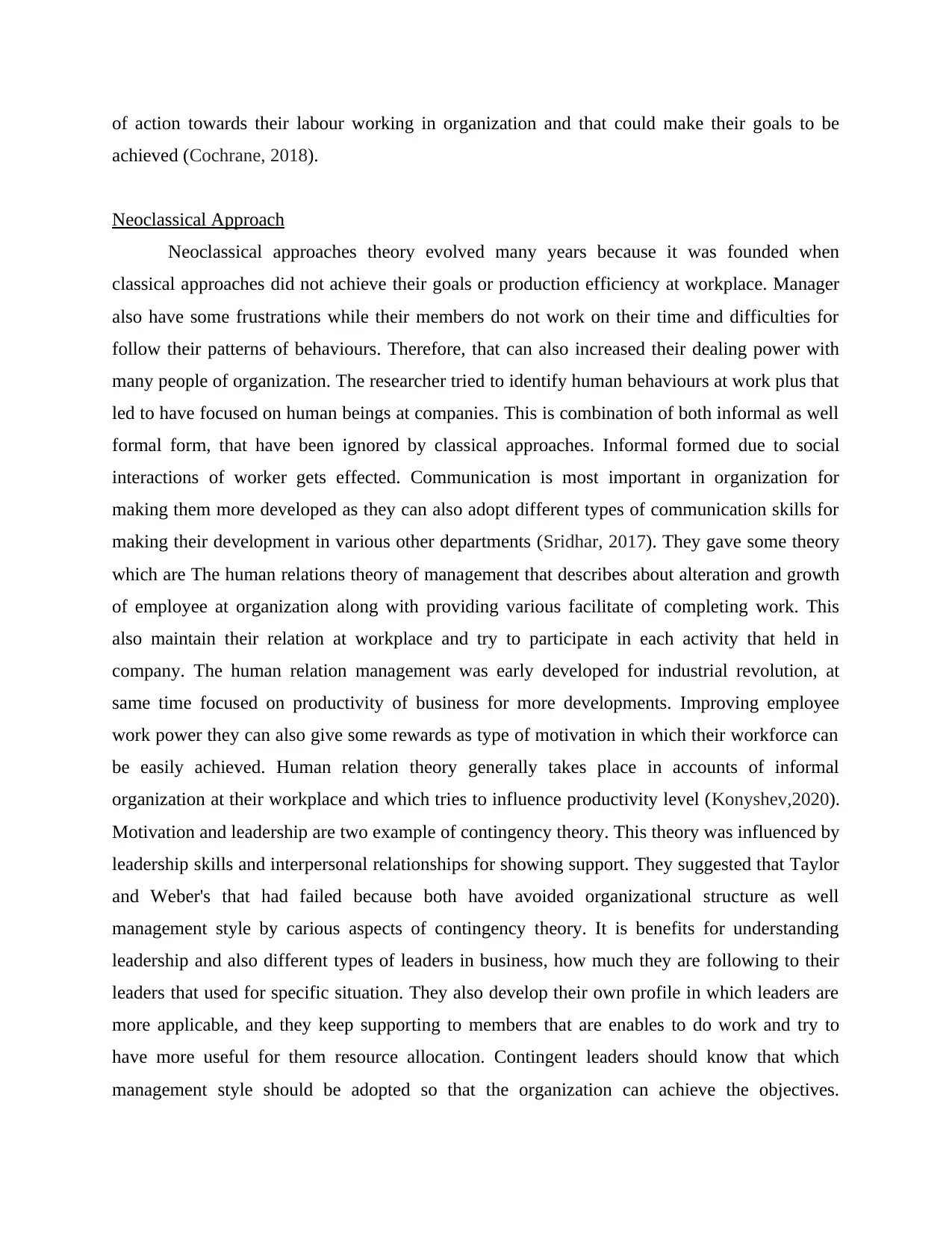
of action towards their labour working in organization and that could make their goals to be
achieved (Cochrane, 2018).
Neoclassical Approach
Neoclassical approaches theory evolved many years because it was founded when
classical approaches did not achieve their goals or production efficiency at workplace. Manager
also have some frustrations while their members do not work on their time and difficulties for
follow their patterns of behaviours. Therefore, that can also increased their dealing power with
many people of organization. The researcher tried to identify human behaviours at work plus that
led to have focused on human beings at companies. This is combination of both informal as well
formal form, that have been ignored by classical approaches. Informal formed due to social
interactions of worker gets effected. Communication is most important in organization for
making them more developed as they can also adopt different types of communication skills for
making their development in various other departments (Sridhar, 2017). They gave some theory
which are The human relations theory of management that describes about alteration and growth
of employee at organization along with providing various facilitate of completing work. This
also maintain their relation at workplace and try to participate in each activity that held in
company. The human relation management was early developed for industrial revolution, at
same time focused on productivity of business for more developments. Improving employee
work power they can also give some rewards as type of motivation in which their workforce can
be easily achieved. Human relation theory generally takes place in accounts of informal
organization at their workplace and which tries to influence productivity level (Konyshev,2020).
Motivation and leadership are two example of contingency theory. This theory was influenced by
leadership skills and interpersonal relationships for showing support. They suggested that Taylor
and Weber's that had failed because both have avoided organizational structure as well
management style by carious aspects of contingency theory. It is benefits for understanding
leadership and also different types of leaders in business, how much they are following to their
leaders that used for specific situation. They also develop their own profile in which leaders are
more applicable, and they keep supporting to members that are enables to do work and try to
have more useful for them resource allocation. Contingent leaders should know that which
management style should be adopted so that the organization can achieve the objectives.
achieved (Cochrane, 2018).
Neoclassical Approach
Neoclassical approaches theory evolved many years because it was founded when
classical approaches did not achieve their goals or production efficiency at workplace. Manager
also have some frustrations while their members do not work on their time and difficulties for
follow their patterns of behaviours. Therefore, that can also increased their dealing power with
many people of organization. The researcher tried to identify human behaviours at work plus that
led to have focused on human beings at companies. This is combination of both informal as well
formal form, that have been ignored by classical approaches. Informal formed due to social
interactions of worker gets effected. Communication is most important in organization for
making them more developed as they can also adopt different types of communication skills for
making their development in various other departments (Sridhar, 2017). They gave some theory
which are The human relations theory of management that describes about alteration and growth
of employee at organization along with providing various facilitate of completing work. This
also maintain their relation at workplace and try to participate in each activity that held in
company. The human relation management was early developed for industrial revolution, at
same time focused on productivity of business for more developments. Improving employee
work power they can also give some rewards as type of motivation in which their workforce can
be easily achieved. Human relation theory generally takes place in accounts of informal
organization at their workplace and which tries to influence productivity level (Konyshev,2020).
Motivation and leadership are two example of contingency theory. This theory was influenced by
leadership skills and interpersonal relationships for showing support. They suggested that Taylor
and Weber's that had failed because both have avoided organizational structure as well
management style by carious aspects of contingency theory. It is benefits for understanding
leadership and also different types of leaders in business, how much they are following to their
leaders that used for specific situation. They also develop their own profile in which leaders are
more applicable, and they keep supporting to members that are enables to do work and try to
have more useful for them resource allocation. Contingent leaders should know that which
management style should be adopted so that the organization can achieve the objectives.

Contingency theory have two variables dependent which include turnover etc and independent
include motivation and leadership. Contingency theory says that there is no method by which the
organization can managed or no best way to lead the company or make decisions as the action is
contingent or dependent on the external and internal factors. These factors include technology,
size of the company, leadership style etc. In other words it can say that the actions are
completely dependent on the situation (Sharma,2019).
Forces that shapes in organization and their structure
Contemporary marketing orientation is process of communication with customer and
much have knowledge about their products. If their features of products is match with the
requirements of customer than they easily achieved their targeted. The contemporary approaches
that can be relationship, industrial and social marketing. Relationship marketing that helps
company have to maintain with their customer. In organization for attracting more other
customer they need to keep healthy relationship so that could be benefits in earning more profits.
Industrial marketing is the process of business to business as they are preparing framework
which assists their strategies to serve with demand of customer. Social marketing is the new
approaches for developing their company with having various effective channels. For more
promoting products and services they can make use of radios, newspaper and creating online
social media platforms. The preference of customer nature is also depended on product rather
than business nature. Hence, it is place where contemporary marketing through customer makes
overall differences. Companies should also create innovative and ideas products in which they
can also gain their customer loyalty. Business to business process might be more benefits in
making their companies unique with some other companies. One products prices must be
different from other products prices so the brands make their different place at marketplace.
Sales and production orientation that assists organization for their future developing structure
among various competition (Line and Wang, 2017).
The cultural excellence approaches refers to everything in which employee asked more
about their organization and co-workers with whom they are working. Rules have been given or
not they should have knowledge about that and practice every activity which make them
excellence in organization. Teach employee for working together without having conflicts
between them about nay work. So they are also allocated as team members rules and regulation
include motivation and leadership. Contingency theory says that there is no method by which the
organization can managed or no best way to lead the company or make decisions as the action is
contingent or dependent on the external and internal factors. These factors include technology,
size of the company, leadership style etc. In other words it can say that the actions are
completely dependent on the situation (Sharma,2019).
Forces that shapes in organization and their structure
Contemporary marketing orientation is process of communication with customer and
much have knowledge about their products. If their features of products is match with the
requirements of customer than they easily achieved their targeted. The contemporary approaches
that can be relationship, industrial and social marketing. Relationship marketing that helps
company have to maintain with their customer. In organization for attracting more other
customer they need to keep healthy relationship so that could be benefits in earning more profits.
Industrial marketing is the process of business to business as they are preparing framework
which assists their strategies to serve with demand of customer. Social marketing is the new
approaches for developing their company with having various effective channels. For more
promoting products and services they can make use of radios, newspaper and creating online
social media platforms. The preference of customer nature is also depended on product rather
than business nature. Hence, it is place where contemporary marketing through customer makes
overall differences. Companies should also create innovative and ideas products in which they
can also gain their customer loyalty. Business to business process might be more benefits in
making their companies unique with some other companies. One products prices must be
different from other products prices so the brands make their different place at marketplace.
Sales and production orientation that assists organization for their future developing structure
among various competition (Line and Wang, 2017).
The cultural excellence approaches refers to everything in which employee asked more
about their organization and co-workers with whom they are working. Rules have been given or
not they should have knowledge about that and practice every activity which make them
excellence in organization. Teach employee for working together without having conflicts
between them about nay work. So they are also allocated as team members rules and regulation
⊘ This is a preview!⊘
Do you want full access?
Subscribe today to unlock all pages.

Trusted by 1+ million students worldwide
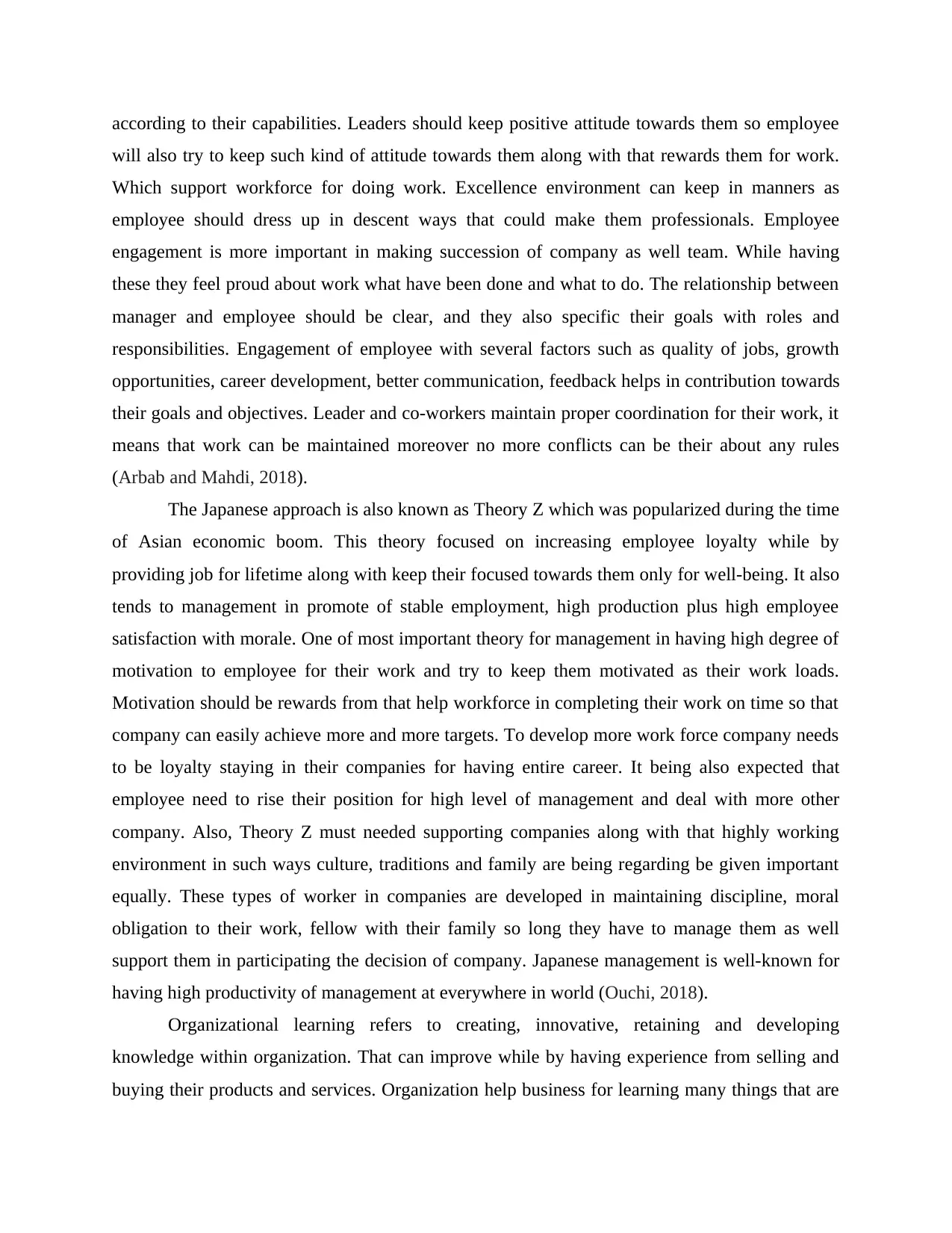
according to their capabilities. Leaders should keep positive attitude towards them so employee
will also try to keep such kind of attitude towards them along with that rewards them for work.
Which support workforce for doing work. Excellence environment can keep in manners as
employee should dress up in descent ways that could make them professionals. Employee
engagement is more important in making succession of company as well team. While having
these they feel proud about work what have been done and what to do. The relationship between
manager and employee should be clear, and they also specific their goals with roles and
responsibilities. Engagement of employee with several factors such as quality of jobs, growth
opportunities, career development, better communication, feedback helps in contribution towards
their goals and objectives. Leader and co-workers maintain proper coordination for their work, it
means that work can be maintained moreover no more conflicts can be their about any rules
(Arbab and Mahdi, 2018).
The Japanese approach is also known as Theory Z which was popularized during the time
of Asian economic boom. This theory focused on increasing employee loyalty while by
providing job for lifetime along with keep their focused towards them only for well-being. It also
tends to management in promote of stable employment, high production plus high employee
satisfaction with morale. One of most important theory for management in having high degree of
motivation to employee for their work and try to keep them motivated as their work loads.
Motivation should be rewards from that help workforce in completing their work on time so that
company can easily achieve more and more targets. To develop more work force company needs
to be loyalty staying in their companies for having entire career. It being also expected that
employee need to rise their position for high level of management and deal with more other
company. Also, Theory Z must needed supporting companies along with that highly working
environment in such ways culture, traditions and family are being regarding be given important
equally. These types of worker in companies are developed in maintaining discipline, moral
obligation to their work, fellow with their family so long they have to manage them as well
support them in participating the decision of company. Japanese management is well-known for
having high productivity of management at everywhere in world (Ouchi, 2018).
Organizational learning refers to creating, innovative, retaining and developing
knowledge within organization. That can improve while by having experience from selling and
buying their products and services. Organization help business for learning many things that are
will also try to keep such kind of attitude towards them along with that rewards them for work.
Which support workforce for doing work. Excellence environment can keep in manners as
employee should dress up in descent ways that could make them professionals. Employee
engagement is more important in making succession of company as well team. While having
these they feel proud about work what have been done and what to do. The relationship between
manager and employee should be clear, and they also specific their goals with roles and
responsibilities. Engagement of employee with several factors such as quality of jobs, growth
opportunities, career development, better communication, feedback helps in contribution towards
their goals and objectives. Leader and co-workers maintain proper coordination for their work, it
means that work can be maintained moreover no more conflicts can be their about any rules
(Arbab and Mahdi, 2018).
The Japanese approach is also known as Theory Z which was popularized during the time
of Asian economic boom. This theory focused on increasing employee loyalty while by
providing job for lifetime along with keep their focused towards them only for well-being. It also
tends to management in promote of stable employment, high production plus high employee
satisfaction with morale. One of most important theory for management in having high degree of
motivation to employee for their work and try to keep them motivated as their work loads.
Motivation should be rewards from that help workforce in completing their work on time so that
company can easily achieve more and more targets. To develop more work force company needs
to be loyalty staying in their companies for having entire career. It being also expected that
employee need to rise their position for high level of management and deal with more other
company. Also, Theory Z must needed supporting companies along with that highly working
environment in such ways culture, traditions and family are being regarding be given important
equally. These types of worker in companies are developed in maintaining discipline, moral
obligation to their work, fellow with their family so long they have to manage them as well
support them in participating the decision of company. Japanese management is well-known for
having high productivity of management at everywhere in world (Ouchi, 2018).
Organizational learning refers to creating, innovative, retaining and developing
knowledge within organization. That can improve while by having experience from selling and
buying their products and services. Organization help business for learning many things that are
Paraphrase This Document
Need a fresh take? Get an instant paraphrase of this document with our AI Paraphraser

required for companies while for developing them from other competitions. The most important
part can learning curve which means for maintaining relationship with customer for products and
services, employee for increasing productivity, efficiency and quality of production can be
simply return with having proper serving of goods. Organization learning can be also affected by
having individual, structure and adopted of technology which must be improved. It happens at
time of learning from organization with having better experience and stay with competitive in
changing environment also and essential required to improvement in increasing profits and
accuracy. Process of creating, retaining, knowledge retention, transfer in knowledge, sharing new
things that bring various adoptive functions in experience of organization. For example. New
pizza store will decrease their costs as per more production of pizza. As this staff of pizza stores
will try to create more and faster products. Working together and equipments being placed at
location for cheaper cost at creation. Learning can be done through having individual, grouping
learning that help people in taking more knowledge and also modified some new ideas, creating
innovation in products (Lin and Sanders, 2017).
CONCLUSION
Through this report it can be concluded that nowadays in the organization neo classical
approaches are used over the classical approach. In this report discussion about classical
approach is done which include scientific management, principles of organization and
bureaucracy. Neo classical theory which includes human relations school and contingency theory
are used by the companies because it is more efficient. This study has discussed about the
approaches which will shape the organization in the future like contemporary marketing
orientation, Japanese approach, organizational learning etc.
part can learning curve which means for maintaining relationship with customer for products and
services, employee for increasing productivity, efficiency and quality of production can be
simply return with having proper serving of goods. Organization learning can be also affected by
having individual, structure and adopted of technology which must be improved. It happens at
time of learning from organization with having better experience and stay with competitive in
changing environment also and essential required to improvement in increasing profits and
accuracy. Process of creating, retaining, knowledge retention, transfer in knowledge, sharing new
things that bring various adoptive functions in experience of organization. For example. New
pizza store will decrease their costs as per more production of pizza. As this staff of pizza stores
will try to create more and faster products. Working together and equipments being placed at
location for cheaper cost at creation. Learning can be done through having individual, grouping
learning that help people in taking more knowledge and also modified some new ideas, creating
innovation in products (Lin and Sanders, 2017).
CONCLUSION
Through this report it can be concluded that nowadays in the organization neo classical
approaches are used over the classical approach. In this report discussion about classical
approach is done which include scientific management, principles of organization and
bureaucracy. Neo classical theory which includes human relations school and contingency theory
are used by the companies because it is more efficient. This study has discussed about the
approaches which will shape the organization in the future like contemporary marketing
orientation, Japanese approach, organizational learning etc.
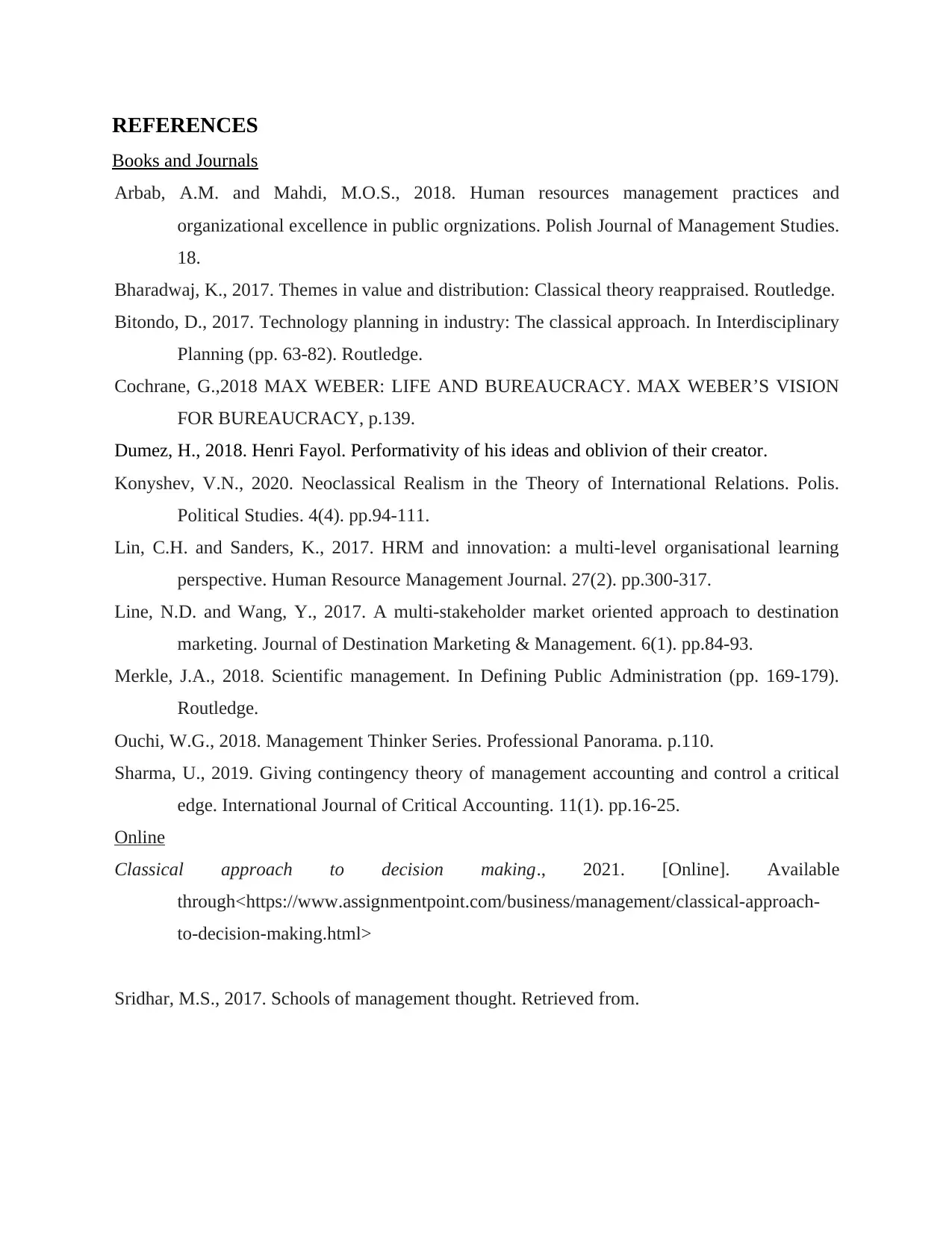
REFERENCES
Books and Journals
Arbab, A.M. and Mahdi, M.O.S., 2018. Human resources management practices and
organizational excellence in public orgnizations. Polish Journal of Management Studies.
18.
Bharadwaj, K., 2017. Themes in value and distribution: Classical theory reappraised. Routledge.
Bitondo, D., 2017. Technology planning in industry: The classical approach. In Interdisciplinary
Planning (pp. 63-82). Routledge.
Cochrane, G.,2018 MAX WEBER: LIFE AND BUREAUCRACY. MAX WEBER’S VISION
FOR BUREAUCRACY, p.139.
Dumez, H., 2018. Henri Fayol. Performativity of his ideas and oblivion of their creator.
Konyshev, V.N., 2020. Neoclassical Realism in the Theory of International Relations. Polis.
Political Studies. 4(4). pp.94-111.
Lin, C.H. and Sanders, K., 2017. HRM and innovation: a multi‐level organisational learning
perspective. Human Resource Management Journal. 27(2). pp.300-317.
Line, N.D. and Wang, Y., 2017. A multi-stakeholder market oriented approach to destination
marketing. Journal of Destination Marketing & Management. 6(1). pp.84-93.
Merkle, J.A., 2018. Scientific management. In Defining Public Administration (pp. 169-179).
Routledge.
Ouchi, W.G., 2018. Management Thinker Series. Professional Panorama. p.110.
Sharma, U., 2019. Giving contingency theory of management accounting and control a critical
edge. International Journal of Critical Accounting. 11(1). pp.16-25.
Online
Classical approach to decision making., 2021. [Online]. Available
through<https://www.assignmentpoint.com/business/management/classical-approach-
to-decision-making.html>
Sridhar, M.S., 2017. Schools of management thought. Retrieved from.
Books and Journals
Arbab, A.M. and Mahdi, M.O.S., 2018. Human resources management practices and
organizational excellence in public orgnizations. Polish Journal of Management Studies.
18.
Bharadwaj, K., 2017. Themes in value and distribution: Classical theory reappraised. Routledge.
Bitondo, D., 2017. Technology planning in industry: The classical approach. In Interdisciplinary
Planning (pp. 63-82). Routledge.
Cochrane, G.,2018 MAX WEBER: LIFE AND BUREAUCRACY. MAX WEBER’S VISION
FOR BUREAUCRACY, p.139.
Dumez, H., 2018. Henri Fayol. Performativity of his ideas and oblivion of their creator.
Konyshev, V.N., 2020. Neoclassical Realism in the Theory of International Relations. Polis.
Political Studies. 4(4). pp.94-111.
Lin, C.H. and Sanders, K., 2017. HRM and innovation: a multi‐level organisational learning
perspective. Human Resource Management Journal. 27(2). pp.300-317.
Line, N.D. and Wang, Y., 2017. A multi-stakeholder market oriented approach to destination
marketing. Journal of Destination Marketing & Management. 6(1). pp.84-93.
Merkle, J.A., 2018. Scientific management. In Defining Public Administration (pp. 169-179).
Routledge.
Ouchi, W.G., 2018. Management Thinker Series. Professional Panorama. p.110.
Sharma, U., 2019. Giving contingency theory of management accounting and control a critical
edge. International Journal of Critical Accounting. 11(1). pp.16-25.
Online
Classical approach to decision making., 2021. [Online]. Available
through<https://www.assignmentpoint.com/business/management/classical-approach-
to-decision-making.html>
Sridhar, M.S., 2017. Schools of management thought. Retrieved from.
⊘ This is a preview!⊘
Do you want full access?
Subscribe today to unlock all pages.

Trusted by 1+ million students worldwide
1 out of 9
Related Documents
Your All-in-One AI-Powered Toolkit for Academic Success.
+13062052269
info@desklib.com
Available 24*7 on WhatsApp / Email
![[object Object]](/_next/static/media/star-bottom.7253800d.svg)
Unlock your academic potential
Copyright © 2020–2025 A2Z Services. All Rights Reserved. Developed and managed by ZUCOL.




